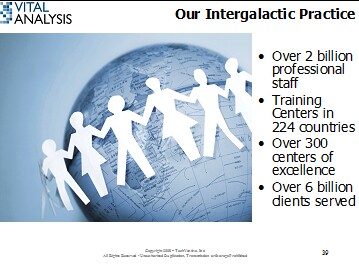The ROI needed to sell software/services

(Hint: It must be substantial and believable)
I do a lot of sales and negotiating training, and contrary to the current economy, it’s becoming a brisk bit of work. That said, there’s often a tough sticking point for many technology and service firms: crafting compelling ROI statements and tying these to some burning platform issue that motivates buyers to move NOW!
Yesterday, I saw an ad that Initiate Systems ran in the Chicago Tribune. Initiate makes MDM (Master Data Management) software and their ad copy identified these ROI statements:
- Saving $10,000/month by eliminating 1,000 pieces of returned mail daily - Reducing days sales outstanding, saving $4 million annually - Improving accuracy of revenue recognition and reporting, translating to $47 million in productivity gains
Amazingly enough, too few technology or service providers can do what Initiate stated. They can’t offer convincing proof of the difference their efforts or products can make. Instead, most firms tell prospects unconvincing attributes about themselves. They subject prospects to endless, narcissistic slides about themselves. Slides with old bromides like:
- We only hire the best people - We deliver value - We have offices in 77 countries - We have over 6200 professionals - Over 200 firms use our products/services - Blah, blah, blah
Those egotistical, self-serving statements are unfortunate on a couple of levels. First, the vendor in question is probably pre-qualified and all of the restatement of qualifications just bores the listener. Second, the prospect doesn’t want to hear the vendor’s boilerplate, generic statements. No, they want the prospect to speak with them about the prospect’s business, its problems and specific methods to clear the issue.
Even when great sales people can show convincing (Note: there is a big difference between selling and convincing) data about a prospect and the financial magnitude of their business problem (or solution opportunity), it is not enough. No, the sales person must also light a fire, figuratively, under the prospect to get them to move on this issue now. This is called ‘creating the burning platform’. In an exercise I had a client complete two weeks ago on a potential prospect, the sales proposal team was stuck on the burning platform statement until one bright lad noted that the prospect was wasting $120 million/month on the wrong advertising going to the wrong demographic and generating little of the company’s much needed sales. That number is hard to get out of any client’s mind and it framed the rest of the sales discussion handily.
If your sales efforts in this economy are flagging, take a critical look at your sales practices and proposal materials. If it’s ego-centric, generic and vague (with regard to value delivery), it won’t work in a tough economy. Prospects today are sitting on their scarce cash reserves and won’t pry open their checkbooks unless you can convince them that:
1) their firm has a real problem; 2) this problem is one of this executive’s top 3 business problems; 3) you absolutely understand this problem; 4) you possess a solution that will solve the problem; and, 5) you can deliver the promised value
Many of the projects that get green-lighted in a tight economy are those that solve break/fix matters. Discretionary (aka nice to have) projects are the ones to get deferred or shot down altogether. Sometimes all a good service or software firm has to do is better understand the prospect and educate them on the materiality of the project. The more your proposed project is seen as a break/fix necessity (and not a discretionary matter), the more likely it will get approved.
